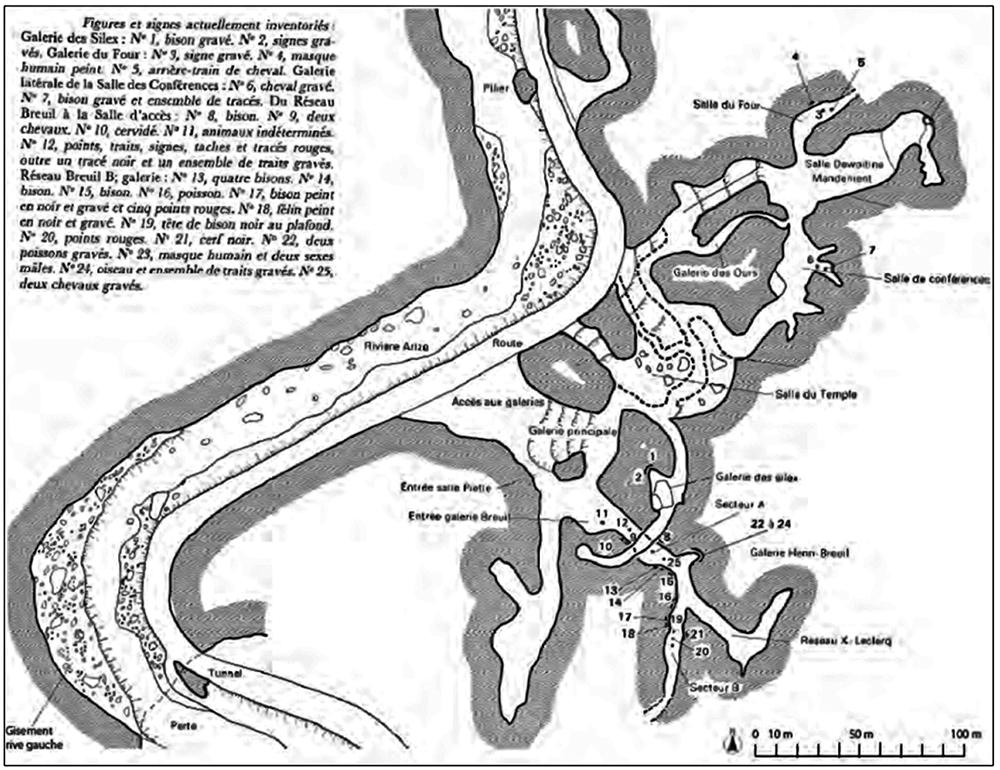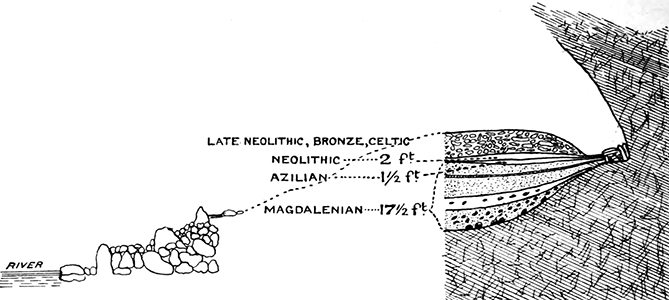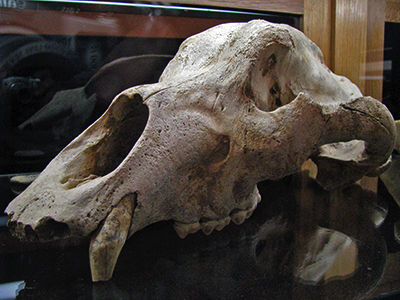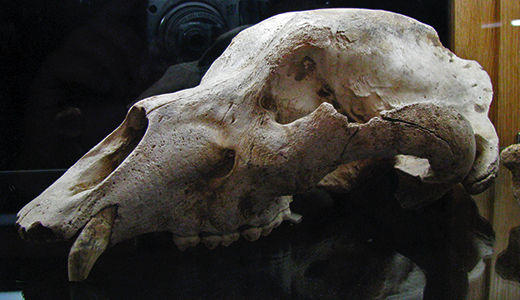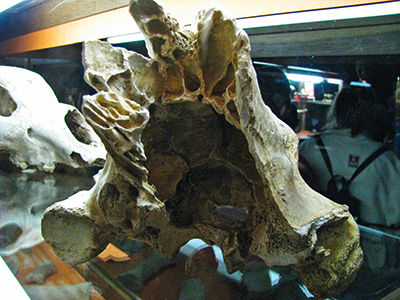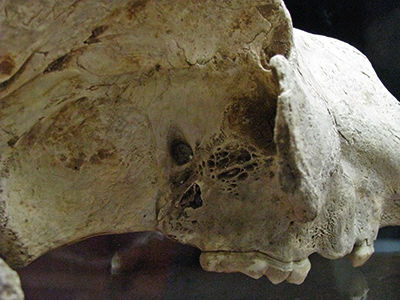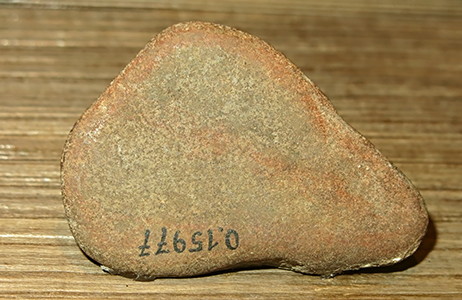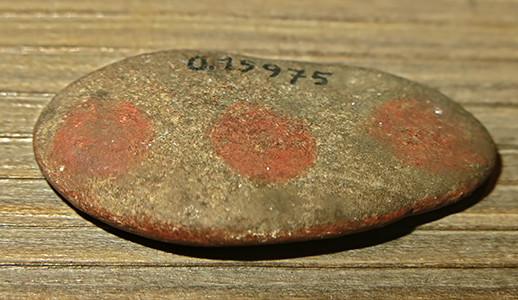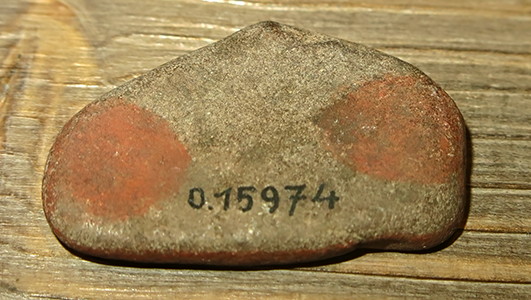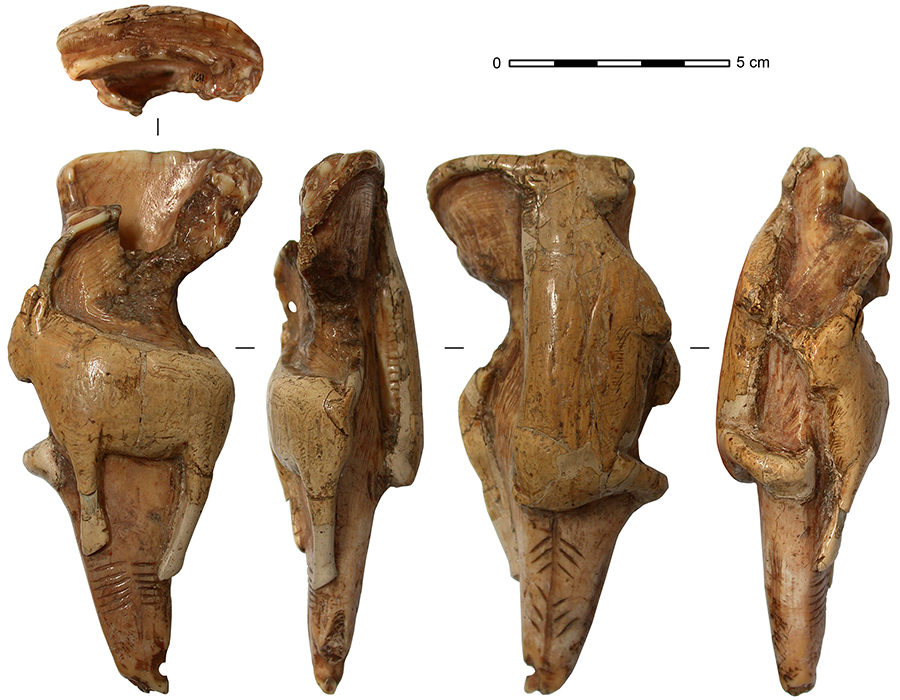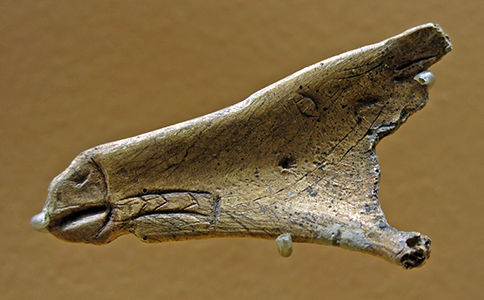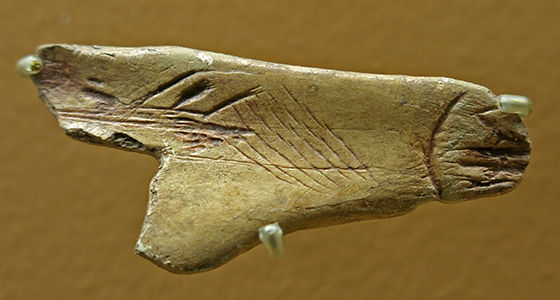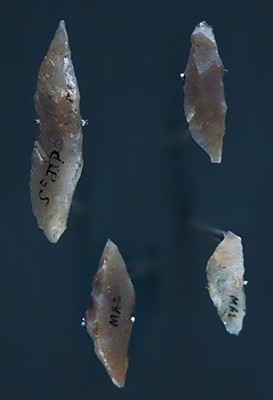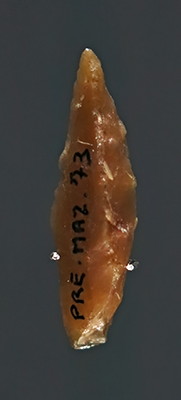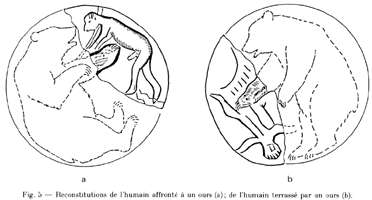Mas d'Azil Cave - La Grotte du Mas d'Azil
The cave of Mas-d'Azil or Grotte du Mas d'Azil is a large, 500 metre long tunnel dug by the Arize River through a wall of the Massif Plantaurelin, part of the Ariege Pyrenees. Secondary caves leading off the main tunnel were occupied at various prehistoric and historic times during a period of 20 000 years, and the objects found there gave the name of the cave to a prehistoric culture, the Azilian. It was excavated by Edouard Piette in the 19th century, who interpreted the halter-like marks on animal heads as being evidence of the domestication of reindeer and horses. The entry of the Arize which marks the beginning of the cave to the south consists of a 51 m high and 48 m wide hole in the massive limestone wall. A main road, the D119 passes through the central section of the cave.
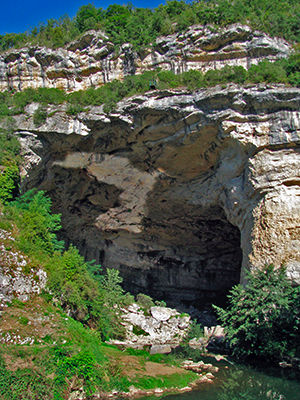
The entry of the River Arize to the southern side of the Grotte. The road through the cave enters on the right of this photograph. It is behind the tree, and the top of the road tunnel may be seen as a dark shadow marginally above the bulk of the tree on the far right.
There is very little water in the river, it may be that there are subterranean passages in the limestone which carry much of the flow during summer.
Photo: Don Hitchcock 2008
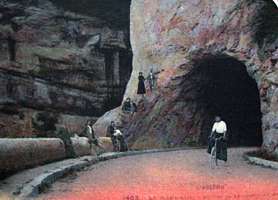
It is interesting to compare the modern photograph above with a postcard from an earlier age, around the early 1900s, this time focusing on the highway entrance to the cave.
Photo: From the display outside Niaux Cave.
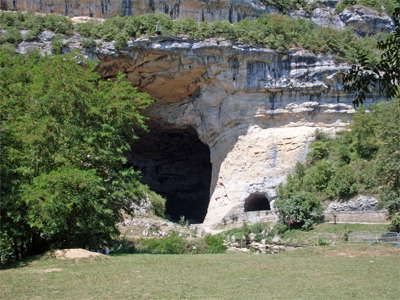
This is a very good photograph of both the southern entrance to the cave by the river, and the entry of the highway to the cave.
Photo: © Traumrune
Permission: © Traumrune / Wikimedia Commons / CC-BY-3.0
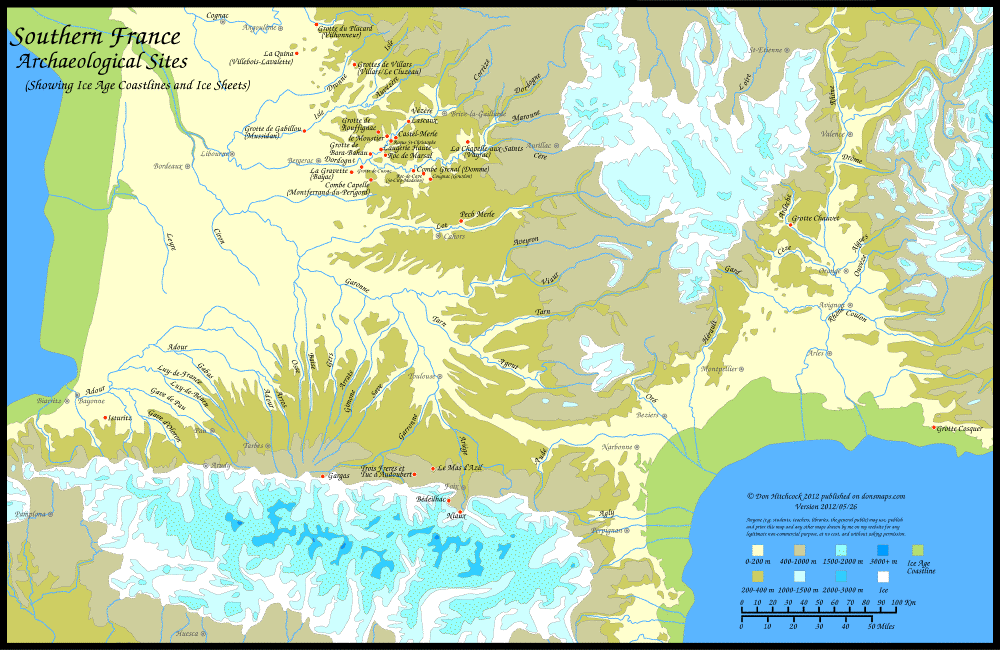
Note - Use this pdf file if you wish to print this map on a single sheet of paper.
Photo: Don Hitchcock version 2012/05/26
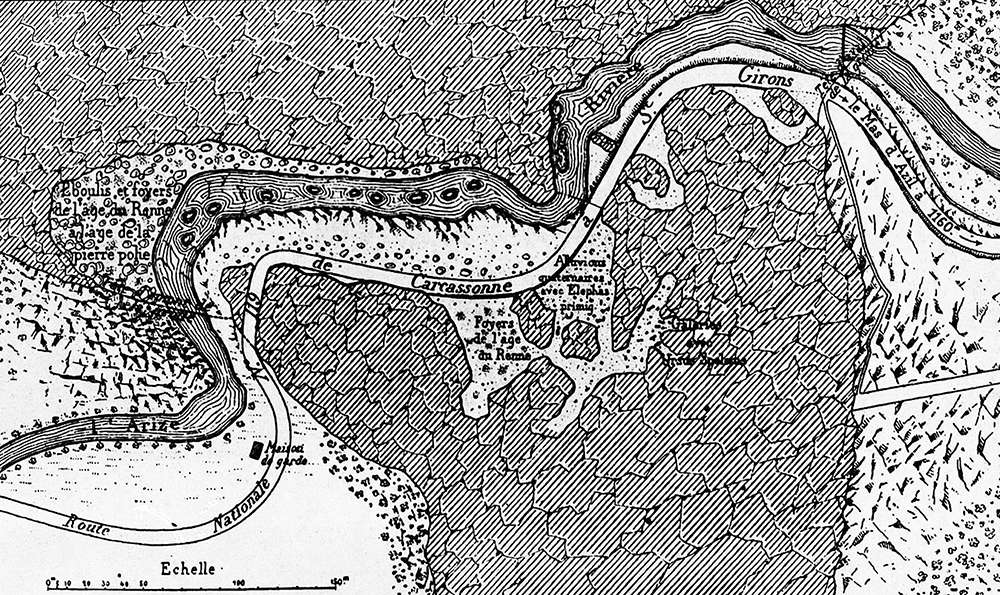
An excellent floor plan of the cave, including the river.
Photo:http://florentrivere.blogspot.com.au/2012/03/le-mas-dazil-nouvelles-decouvertes-1.html
Another floor plan of the cave, including named sections of the cave and various features within it. Figures and signs are from the Flint Gallery.
1 Engraved Bison
2 Engraved signs
3 Engraved sign
4 Painted human mask
5 Hindquarters of a horse
6 Engraved horse
7 Engraved bison and a collection of lines
8 Bison
9 Two horses
10 Deer
11 Indeterminate animals
12 Points, lines, signs, spots and red marks, as well as a black mark and a series of engraved lines
13 Four bisons
14 and 15 Bison
16 Fish
17 Engraved bison painted in black and five red dots
18 Engraved feline painted in black
19 Head of a black bison on the roof
20 Red dots
21 Black deer
22 Two engraved fish
23 Human mask and two male genitalia
24 Bird and a collection of engraved lines
25 Two engraved horses.
Photo: Alteirac et al. 1984
M. Piette's section across the strata at Mas d'Azil.
Photo: Keith (1915)

The River Arize and the main road, the D119, disappear under the ground, and reappear at the point labelled Grotte du Mas-d'Azil, 09290 Le Mas-d'Azil, France.
The coordinates for the southern entrance to the cave are:
43° 4.085' North, 1° 21.252 East.
Altitudes are 360 m for the river at the entry point to the cave, and 422 m for the top of the cave at the entry.
Photo: Google Earth
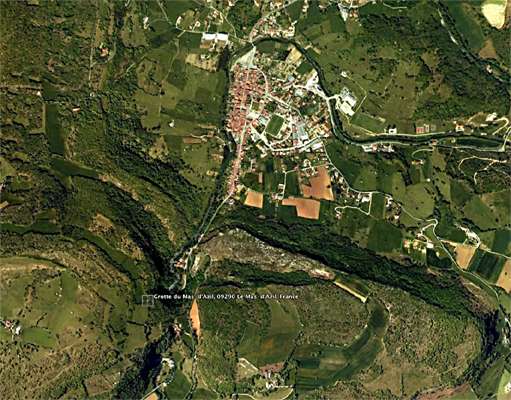
The village of Mas-d'Azil is further downstream, to the north, inside a bend in the River Arize.
Photo: Google Earth

The Grotte du Mas d'Azil is at the part of the sign labelled Grotte Préhistorique.
Photo: Sign, Grotte du Mas d'Azil
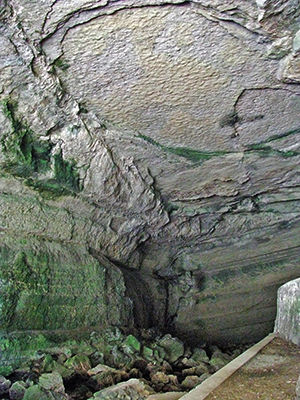
If you follow the pedestrian path beside the river, there is access to the first part of the grotte and river.
The roof is relatively flat, but there are many limestone boulders in the bed of the river. The path finishes at this point.
Photo: Don Hitchcock 2008

There is a narrow walkway beside the main road, and in this view one can see that the road and the river join not far into the grotte.
The entrance to the other caves and display areas is to the right of the road, where the pedestrian crossing may be seen in this photograph.
Photo: Don Hitchcock 2008

Looking back upstream from the walkway along the road, we can see the southern entrance of the river to the grotte, and the light reflecting off the stream, with the roof of the grotte far overhead. The angular end of the short pedestrian path to the start of the grotte may also be seen in silhouette in this photograph.
Photo: Don Hitchcock 2008

It is possible to take the narrow path beside the main road all the way to the other end of the grotte, with brilliant sunshine outlining the exit of the stream and the road.
Although there is lighting at the edge of the road, cars are required to turn on their headlights when entering the grotte.
Photo: Don Hitchcock 2008
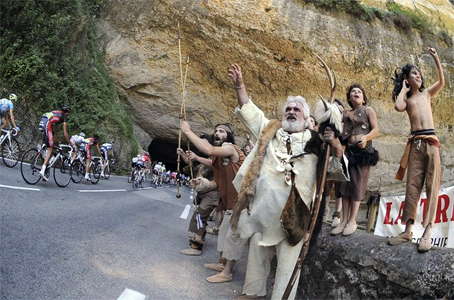
Le Tour de France entering the northern side of the Mas d'Azil, during the Pamiers to Luchon stage, cheered on by Paleolithic hunters in full walking out dress!
What a delightful photo!
Photo: Evènement: Pamiers/Bagneres du Luchon
Date: 19/07/2010
Source: © Presse Sports
Photographe: Mounic Alain
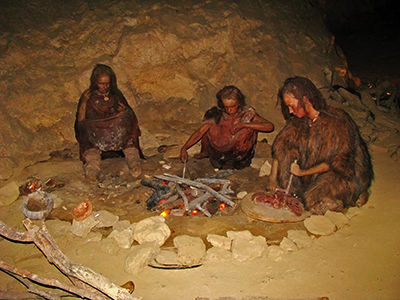
This is the first display on entering the conducted tour part of the caves.
Tipping for the guide is expected in this cave, as has been the case for many years.
Photo: Don Hitchcock 2008
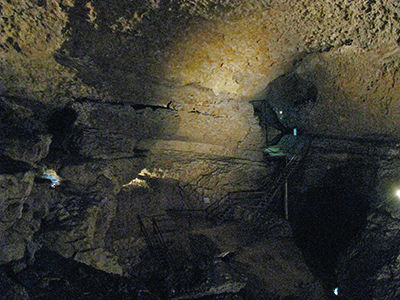
Parts of the cave are huge, and have sheltered many people during time of war.
Photo: Don Hitchcock 2008

The display area is in a smaller, side cavern. There is a good display of Cave Bear bones.
Photo: Don Hitchcock 2008

The Cave Bear bones appear to be originals.
Photo: Don Hitchcock 2008
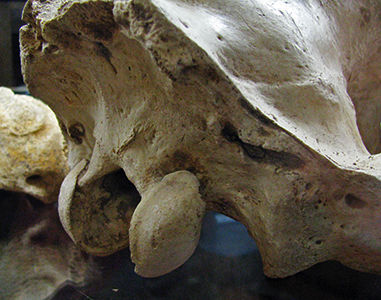
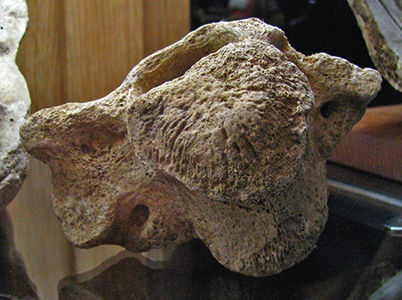
Unfortunately, there is very little descriptive labelling, which would have been a big help.
Photo: Don Hitchcock 2008

There are few displays of the finds related to humans in the cave. This is possibly the best, a facsimile of a famous propulseur from Mas d'Azil in the shape of the front of a bouquetin, or ibex.
Propulseurs were attached to a piece of wood, and used as a throwing stick for lightweight and whippy spears, or darts, as they are more properly called.
The hook on the end of the propulseur (also called an atlatl or a woomera or spear thrower in other parts of the world) fitted into the end of the dart, and gave the hunter more control and greater leverage to send the dart very much further, and with more force. It was a very important development in technology.
Photo: Don Hitchcock 2008
Source: Facsimile, display, Grotte du Mas d'Azil




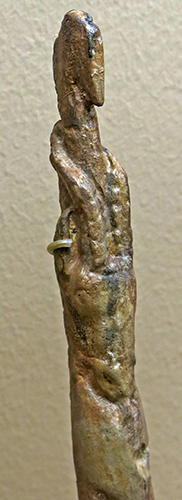
Various views of the ibex propulseur from Mas d'Azil.
Note the double bevel at the base of the propulseur, used to attach it in a corresponding wedge in a wooden handle, a method often used for spear points.
Photo: Don Hitchcock 2014
Source: Facsimile, Musée d'Archeologie Nationale et Domaine, St-Germain-en-Laye

A drawing of the original propulseur shown in facsimile above.
Photo: Wikimedia Commons
Source: Propulseur paléolithique du Mas d'Azil (Ariège, France) - bouquetin de face et de profil.
Paleolithic spear-thrower showing an Ibex.
personal scan from Manuel d'archéologie préhistorique, celtique et gallo-romaine, fr:Joseph Déchelette (1862-1914)
Licensing: Public domain This image is in the public domain because its copyright has expired.

Propulseur 'au faon' (moulage) Le Mas d'Azil (Ariège), Magdalénien supérieur.
Photo: Don Hitchcock 2008
Source: Facsimile on display at Le Musée National de Préhistoire, Les Eyzies-de-Tayac

Spearthrower made of antler showing a fawn or doe with an emerging turd (or a baby deer being born) on which two birds are perched, found around 1940 in the cave of Le Mas d'Azil, Ariege.
Also identified as a young ibex or chamois by many writers. Neither Ibex nor chamois is likely, for as another student of the Palaeolithic, AnnDee, says, (pers. comm):
The females of both those animals have horns, and it is one of the defining features of the animals. It would have taken very little for the artist to leave a bit more along the edge of the ears and carve the suggestion of horns. The animals do look young, but, if it is a birth scene, must be adult females.
I suggest it's a red deer hind, a fallow deer doe, or a roe deer doe giving birth. There were a lot more red deer remains than ibex and/or chamois remains (according to the chart at the bottom of the page). It probably isn't reindeer because most reindeer cows have antlers (although, on looking into it, they shed their antlers and give birth at about the same time, so perhaps it is a reindeer cow--there are more reindeer remains than everything else put together!)
Photo: Don Hitchcock 2008
Source: Facsimile on display at Le Musée National de Préhistoire, Les Eyzies-de-Tayac
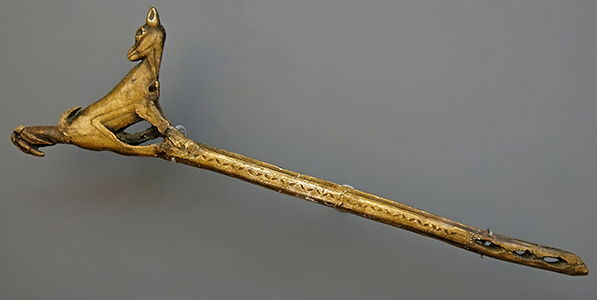
Another higher definition image of the spearthrower above.
Photo: Don Hitchcock 2014
Source: Facsimile on display at Le Musée National de Préhistoire, Les Eyzies-de-Tayac

This was one of the first examples of mass produced art. Fragments of up to ten examples of this design have been found, which means that scores or hundreds must have been manufactured originally. The joke must have been very popular amongst the people of the time!
The fawn or doe figure alone is about 7 cm long, and dates to about 16 000 BP. The entire propulseur is 29.5 cm in length.
The engraved line along the body of the animal possibly represents a change in the colour of the coat.
Although most authorities give the interpretation of a turd with birds above, Bandi (1988) proposes that the 'sausage' coming out of the back of the ibex/chamois is the sac of an infant, and the animal is giving birth. The reasons given are that animals never look back to see their own excrement, but usually do so when giving birth. In addition, the author says that the object is too thick to be excrement, it is much more likely to be the sac of an infant.
The eyes are cupules which originally would have been filled with resin or amber.
Photo: Don Hitchcock 2008
Source: Facsimile on display at Le Musée National de Préhistoire, Les Eyzies-de-Tayac
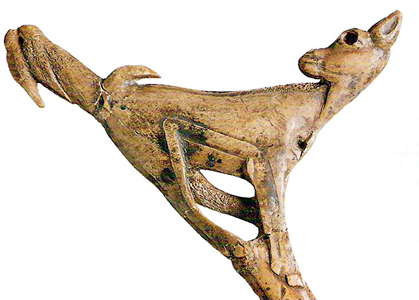
Another version of the deer/ibex/chamois and birds propulseur. This photograph may be of the original. Originally called a fawn, some have called it an ibex or chamois, though it lacks even the semblance of horns, and could easily be a doe. The sausage coming out of the back of the animal may well show the act of giving birth rather than defecating, since all these animals defecate small pellets, not turds.
Photo: http://www.arize.fr/Le-Faon-aux-oiseaux.html

Part of a propulseur or spear thrower, carved in the image of a fawn, a doe, a young ibex or chamois, from Isturitz.
There were many pieces in exactly this style fashioned at one period. Complete examples have the fawn looking over its shoulder at a turd coming out of its rear end, with two parrots on the turd, with their tails forming the hook of the spear thrower.
Photo: Don Hitchcock 2014
Source: Facsimile, Musée d'Archeologie Nationale et Domaine, St-Germain-en-Laye


Part of spear throwers, carved in the image of a fawn, a doe, a young ibex or chamois, from Saint-Michel-à-Arudy, Pyrénées-Atlantiques.
Photo: Don Hitchcock 2014
Source: Facsimile, Musée d'Archeologie Nationale et Domaine, St-Germain-en-Laye
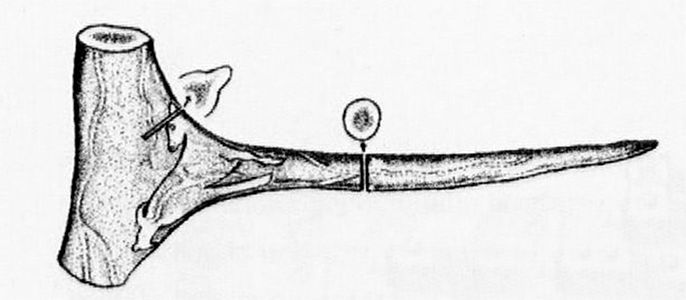
The engineering problem was how to use as much of the external dense antler cortex as possible and as little of the more fragile interior medulla, especially for the fragile projecting elements in the design.
Photo and text: Guthrie (2005)
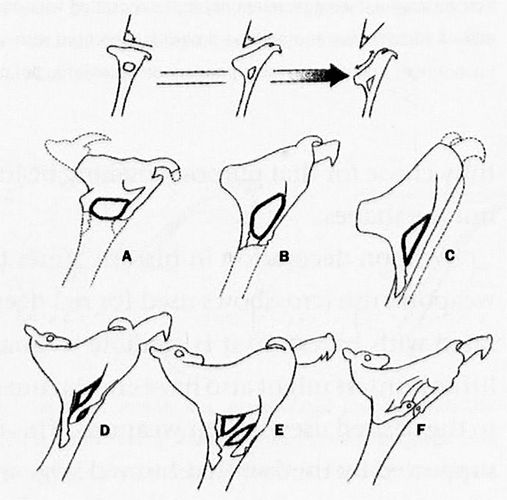
Spear throwers are high-energy weapons of violence and thus easily broken. One can reconstruct the design stages that made this atlatl weight more durable. The pattern to the left, A, is reconstructed from various fragments at different sites.
It had several problems. One was that the upright legs were too fragile a connection between the shaft and weight. The shaft-weight contact could be strengthened by artfully angling the mass slightly down the shaft and by making the opening between the legs more angular or eliminating it altogether:
B-C Arudy
D-E Mas d'Azil
F Bédeilhac.
Photo and text: Guthrie (2005)
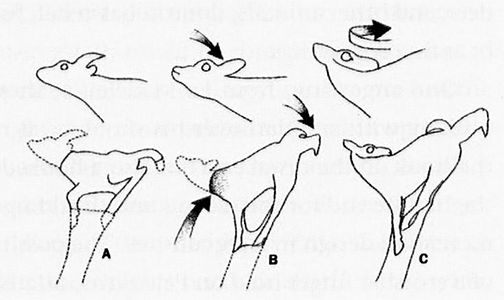
The fragile protruding head was strengthened by portraying a young hornless ibex or by rounding the shoulder and making it headless (some of the latter are probably repairs of weapons with heads broken off). And finally, the designers circumvented this whole problem by artfully twisting the head rearward and incorporating it into the shoulder structure.
A: reconstructed early form of this design
B: Arudy
C: Mas d'Azil
Photo and text: Guthrie (2005)

Another problem with the original design was that the little tail was too fragile as a spur with which to engage the dart. This was circumvented by avoiding the tail altogether (A) and instead using a thick projection of faeces (B).
On some of these atlatls the tail was lifted forward (C) in characteristic ibex posture. Curving the faeces to make the spur for the dart made it look like a perched bird. This upright perch was characteristic of one main group of birds, woodpeckers - and the designers made that explicit. Two of the most widespread woodpecker species in Europe today are barred across their backs as on the Palaeolithic atlatl: Dendrocopos minor, the lesser spotted woodpecker, and the larger D. leucotus, the white-backed woodpecker (D and E).
The woodpecker perching on the faeces combined with the ibex's head turned in that direction makes for a touch of humour. The lines of all this action combine to make a thing of balance, heft, and beauty.
Photo and text: Guthrie (2005)
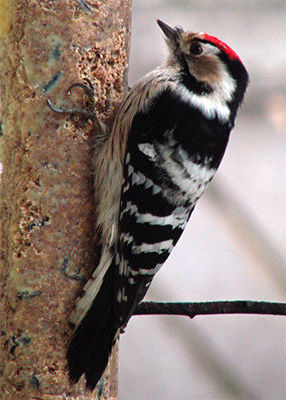
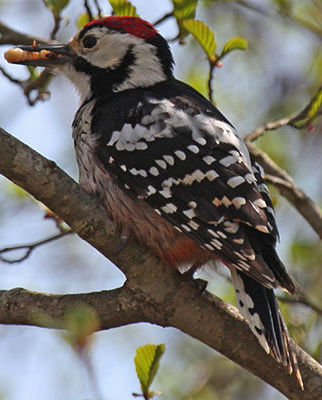
(left) Lesser woodpecker.
(right) White-backed woodpecker
Photo (left): Zaltys
Photo (right): Alastair Rae
Permission: Creative Commons Attribution-Share Alike 3.0 Unported license.
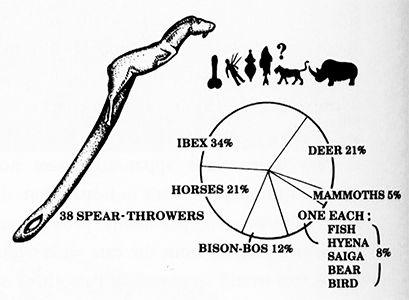
The majority of preserved atlatls are decorated with representational images. What images does one put on such a tool? Here is a Palaeolithic sample of thirty-eight atlatls.
Most of the images are of commonly hunted large mammals (as we know from archaeological middens). Images of mammoths, fish, rhinos, and carnivores are rare, and it is quite possible that atlatls were not regularly used on those species. Speared humans or war scenes are unknown on atlatls. I surmise that this means something - that weapons were made only with hunting in mind and not hostility. Erotic images of women, vulvae, and penises are also absent.
This tool was carried publicly, suggesting that flagrant erotica was discouraged. Such aesthetic constraints are not merely modern cultural products but persist because of deep tensions over paternal uncertainty and incest taboos.
Photo and text: Guthrie (2005)
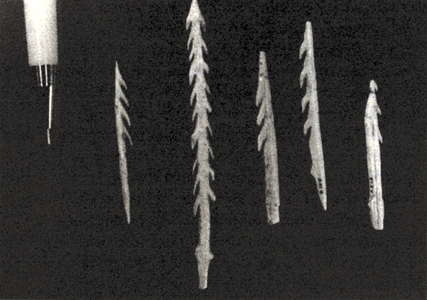
These small, delicate harpoons (note the size of the pen in the photo) look hardly sufficient to bring down any animal, but perhaps they were made to shoot birds, or small fish.
Made of antler. Of the same material, and contemporaneous with, the propulseur above.
Mas d'Azil.
Photo: Schiffer (2001)
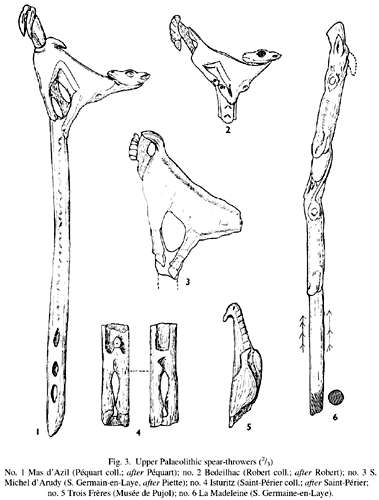
These drawings are useful to demonstrate the ubiquity and spread of the propulseur design above, at other places such as Bedeilhac and St Michel d'Arudy.
Source: Palaeolithic Spear-Throwers. Garrod, D. Proceedings of the Prehistoric Society 21, 1955.
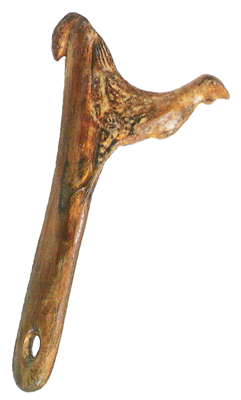
Propulseur, or atlatl, carved in the form of a grouse or ptarmigan in the Magdalenian, and discovered by Piette at Mas d'Azil.
This is a reconstruction of the original propulseur, whose head and legs were fractured when found. The hook at the level of the tail was also absent. The tail feathers are indicated by parallel lines, and the wings are folded on the body.
The neck has a protrusion corresponding to a fleshy growth or a tuft of feathers such as the males of some bird species such as the grouse have.
The body and the head were discovered by different excavators at different times, and the reconstruction was then performed.
(Note that a hole has been bored through the shaft of the propulseur at one end, so that it could be attached to a belt or the wrist by a thong, or perhaps used to secure the attachment of the piece to a shaft to make the propulseur longer - Don )
Photo: http://www.arize.fr/Le-coq-de-Bruyere.html
Text: Translated and adapted from http://www.arize.fr/Le-coq-de-Bruyere.html

Painted stones. These were faked in large numbers soon after their discovery.
Photo: Plazy (2001)
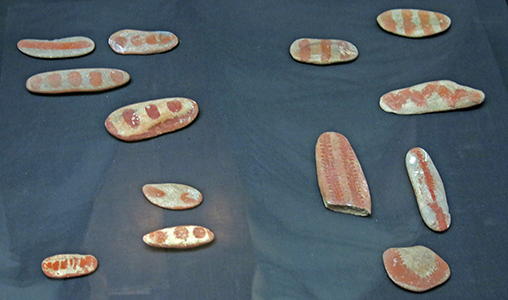
Painted pebbles from Mas d'Azil. Note the fern-like patterns on some of the stones.
Photo: Don Hitchcock 2014
Source: Musée d’art et d’archéologie du Périgord, Périgueux

Pebbles from Mas d'Azil.
In the Mas d'Azil cave in France, over 1300 painted and engraved river pebbles were collected 13 000 - 14 000 years ago. They show geometric red and black characters, dots, dashes, or dentate ornaments.
Nowhere else is there such a quantity of these pebbles, evidently a regional custom of the Pyrenees. Were they magical stones? A shaman's tools of trade?
Photo: Don Hitchcock 2015
Source and text: Monrepos Archäologisches Forschungszentrum und Museum, Neuwied, Germany
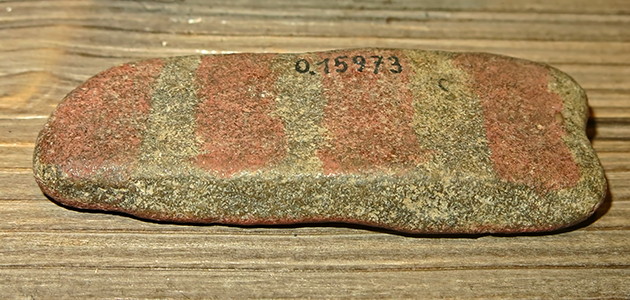
Pebbles from Mas d'Azil.
Photo: Don Hitchcock 2015
Source and text: Monrepos Archäologisches Forschungszentrum und Museum, Neuwied, Germany

Panel of four bison from Mas d'Azil.
Photo: Alteirac et al. 1984

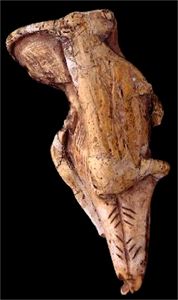
Two Ibex, carved on both sides of a lower tooth of a sperm whale, discovered by Maury. One of the ibex is sideways, and one is longitudinal on the tooth.
Photo: Bouquetins sculptés sur dent de cachalot
Catalogue n° 354
Grotte du Mas-d'Azil, Ariège
Musée des Antiquités nationales, Saint-Germain-en-Laye
© photo - Loïc Hamon
Photo Source: http://www.culture.gouv.fr/culture/app/fr/47257.htm
Carved and perforated sperm whale tooth, Mas d’Azil (Ariège, France), Middle or Late Magdalenian, Piette collection, musée d’Archéologie nationale (MAN 47257).
Photo: Dupont et Marchand (2014)
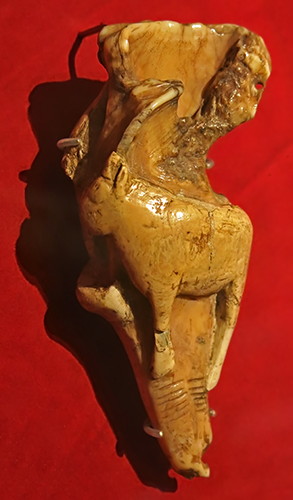

The ibex are wrapped around the edge of the tooth, and three perforations were made in the tooth (one of which has been broken out), presumably so that the sculpture could be worn as a pendant. A carved sperm whale tooth is very rare in prehistoric sites. Presumably the whale beached, and the carcass was scavanged for usable items, including this tooth, which was subsequently carried or traded to Mas d'Azil, which is a long way from the sea.
Middle Magdalenian, from Mas-d'Azil, the upstream cavern of the right bank of the river Arise, at the base of the lower gallery.
Pierced tooth with 3 perforations. It is a lower left sperm whale tooth. Two ibexes are carved in relief on the tooth: - on one side, an ibex of left profile, arranged transversely to the longitudinal axis of the tooth, has the snout and the horn fractured. The hind hoof was redone at mid-height.
Below the legs are two sets of six transverse and parallel incisions. On the other side, a long horned ibex, with a straight profile, is arranged longitudinally along the main axis of the tooth. His fore hoof touches the muzzle of the first ibex. Below the hindquarters of the second ibex, a median groove is confined to two series of three oblique and parallel lines, forming interlocking chevrons. The object has three perforations.
The convention of winding around the edges of the tooth was chosen by the sculptor, no doubt to create an elongation of the figures. These figures, however, retain correct proportions. The funnel above the transversal ibex, is the pulp of the tooth. The cavity was shortened by ablation of the edge.
Dimensions: Length 125 mm, width 50 mm, thickness 37 mm.
Catalog: 47257
Photo: Don Hitchcock 2015
Source: Original, La Salle Piette, Musée d'Archeologie Nationale et Domaine, St-Germain-en-Laye
Additional text: Text: © musée des Antiquités nationales, © Direction des Musées de France, 2000

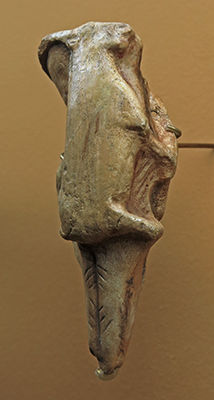
Ibex sculpted on the tooth of a sperm whale.
This view shows the other side of the sculpture, with the ibex shown vertically on the tooth.
Photo: Don Hitchcock 2014
Source: Facsimile, Musée d'Archeologie Nationale et Domaine, St-Germain-en-Laye
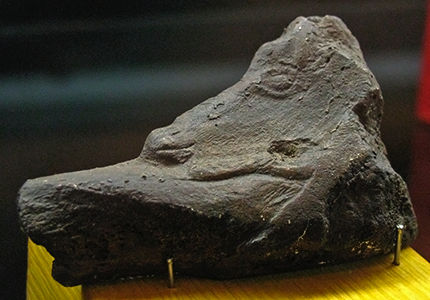
Possibly a bovine.
Photo: Don Hitchcock 2008
Source: Facsimile, display, Grotte du Mas d'Azil
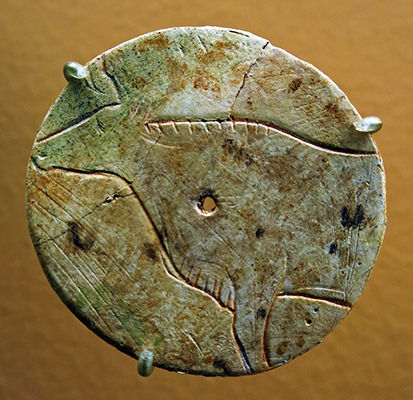
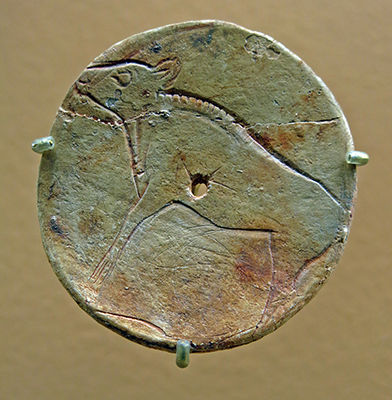
Engraving of an aurochs and a bison from Mas d'Azil.
Some say that this may have been used as a button, the two sides are quite different. (I believe that this, and all similar rondelles are weights for drop spindles for spinning yarn - Don ) The one on the left depicts an adult aurochs considered a female because of the fine features of the head. The withers and chest are marked with small incisions. Horns and ears are sketched. The eye and the nostril are shown as points.
The other side of the disk shows a young bison, which, according to the size of the horn and the curvature of the hump might be about five months old. This young bison is half the size of the adult animal. Again, we find the same incisions along the shoulder and the chest. Aurochs females sometimes adopted baby bison.(I assume similar behaviour between cattle and bison has been recorded in zoos - Don )
(note also that the French Wikipedia wrongly credits the young bison rondelle as coming from Bédeilhac - Don )
Text: http://www.musee-archeologienationale.fr/template.php?SPAGE=2276
Photo: Don Hitchcock 2014
Source: Facsimile, Musée d'Archeologie Nationale et Domaine, St-Germain-en-Laye
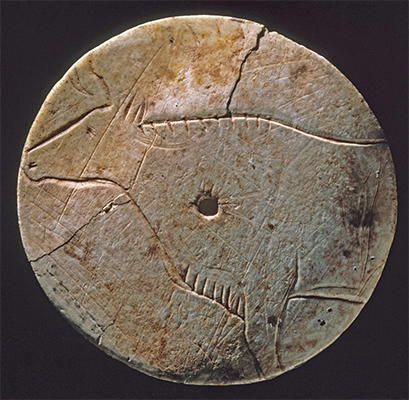

Disc discovered by Marthe and Saint-Just Péquart during excavations of the Magdalenian layers of the Mas d'Azil Cave.
This appliqué, which was possibly sewn onto clothing, was cut from a scapula and engraved on both sides with figurative patterns. On one side is a female auroch, and on the other a young bison.
Length 51 mm, width 49 mm, thickness 1 mm. MAN 77 558
Photo:
© RMN-Grand Palais (musée d'Archéologie nationale) / Loïc Hamon
Source: http://www.sculpture.prehistoire.culture.fr/en/contenu/research.html#-multi-disciplinary-research
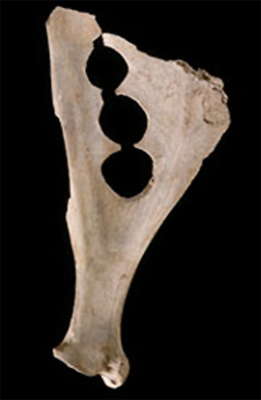
This scapula from Mas d'Azil was used as the base material for round disks similar to the ones above.
To the casual observer, it might seem that not much care was taken in making the discs completely round at the roughing out stage. However I have made my own rondelles from a sheep scapula, and even with modern tools it is by no means easy to get a completely circular disc.
Photo: http://www.musee-archeologienationale.fr/template.php?SPAGE=2276
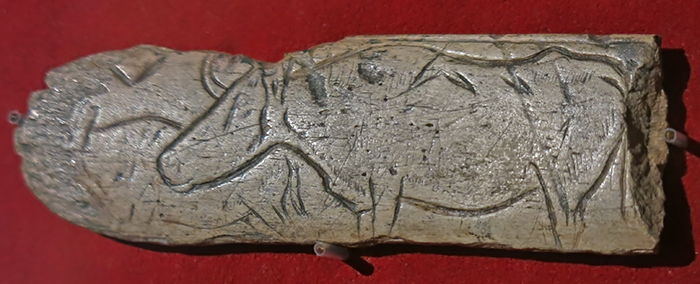
Lissoir or smoother, carved with aurochs and chevrons. Reindeer antler. Grotte du Mas d'Azil. Magdalenian middle / upper. Age 15 000 / 11 000 BP. Excavations of Edouard Piette, 1887-1894.
Text: http://www.spectacles-selection.com/archives/expositions/
fiche_expo_S/saint_germain_salle_piette/salle_piette_visuels.htm
Source: Original, Musée d'Archeologie Nationale et Domaine, St-Germain-en-Laye, Salle Piette
(Lissoirs were an essential tool in the process of turning animal hides into leather. The hide was stretched on a wooden frame, and the hide was worked from both sides (unless a fur was required, rather than leather, in which case only one side was worked), stretching and working it to make it supple and useable for clothing and other purposes. Often the brains of the animal killed were worked into the hide to make it soft, and fat and ochre were rubbed into it using the lissoir, to colour it, preserve it, and make it water resistant - Don )
Two aurochs of unequal size are etched on this fragment of a smoother. The surface of the bone, damaged at the used part of the object, has removed the head of the first animal.
The opposite end is broken transversely and the fracture starts at about the hindquarters of the second animal.
The engraving is deep, carved in one continuous, sure line, and the contour lines express a flexible and precise knowledge of the anatomical details of the two animals. A small chip which affects the upper edge of the object has also removed one of the horns of the animal.
This piece apart from the technical prowess of execution to which it bears witness, is particularly interesting because it is one of the notable examples of the use of the third dimension. The two animals are in fact placed on different planes, the smallest being the farthest from the observer in accordance with the laws of perspective.
This scene, because of differences in size between the two animals and the lack of sex characteristics of the aurochs, was interpreted as the representation of a cow and her calf. However, there is nothing to support such a hypothesis. The first ox is seen as a calf only because it is smaller than the second, but we also know that the relative sizes of animals were not heeded in Paleolithic art. A hind could be drawn much larger than a bison, for example. The general proportions of the small bovine are in fact comparable to that of the other animal. The enlarged withers leading down to the saddle and the dewlap which is prominently marked show it to be, on the contrary, an adult animal.
It is better to see in this example a composition showing perspective demonstrated by superposition.
Text: translated and adapted from the above and from http://www.arize.fr/Bovides-sur-lissoir.html
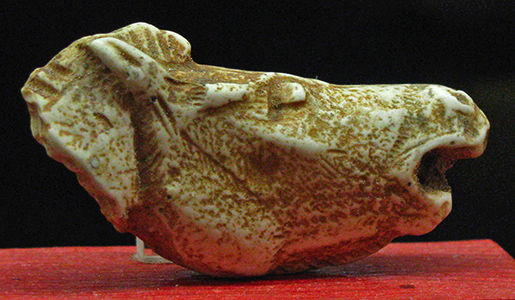
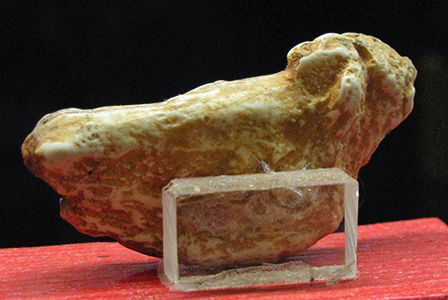
Facsimile of the famous sculpture of a horse head from Mas d'Azil, front and back.
Photo: Don Hitchcock 2008
Source: Facsimile, display, Grotte du Mas d'Azil
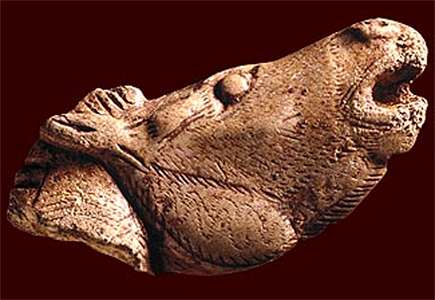
Cheval hennissant (neighing horse)
vers 13 000 av. J.-C., bois de renne
About 15 000 BP, reindeer antler
Le Mas d’Azil (Ariège)
Photo: http://www.musee-antiquitesnationales.fr/
(note that I have flipped this image vertically, then through 180 degrees to conform with the other images on this page - Don)
Source: Original, display, Musée d'archéologie nationale, Saint-Germain-en-Laye
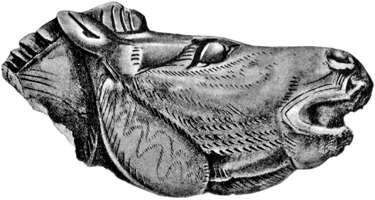
... and the original drawing by Édouard Piette.
Photo: Wikimedia commons
Description: Deutsch: Darstellung eines prähistorischen Pferdekopfs aus Mas d'Azil (Pyrenäen, Frankreich) Museo de Saint-Germain-en-Laye
Date:1913
Source: Congrés international d'Anthropologie et d'Archéologie préhistoriques. Ginebra 1913
Author: Édouard Piette
Permission: This image is in the public domain because its copyright has expired.

And yet another image, also from the Musée des Antiquités Nationales, Saint Germain-en-Laye. of what looks like a facsimile.
Photo: Wikimedia commons
Permission: GNU Free Documentation License, Version 1.2

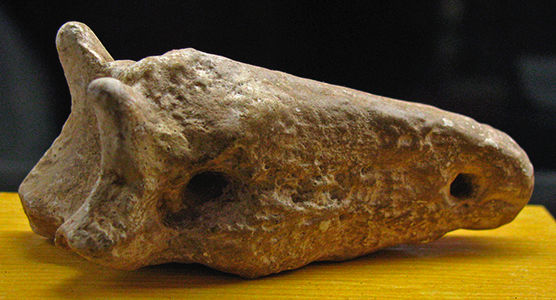
Sculpture of an animal head, possibly a horse.
The object may have had a distinct purpose, apart from decoration, judging by the holes in it, and the projections at one end.
Photo: Don Hitchcock 2008
Source: Facsimile, display, Grotte du Mas d'Azil
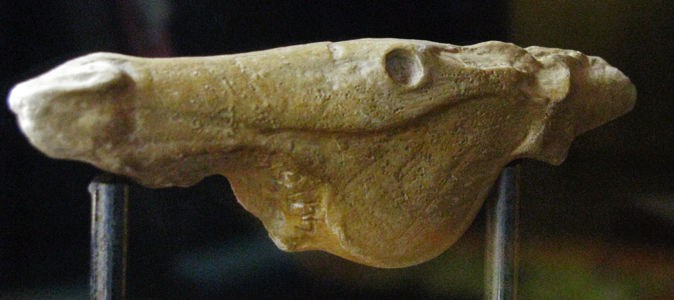
Sculpture of a horse head.
The object was originally a spear thrower, see below, which may account for the distorted look of the image.
Photo: Don Hitchcock 2008
Source: Facsimile, display, Grotte du Mas d'Azil

Spear thrower.
Photo: Cattelain (2005)
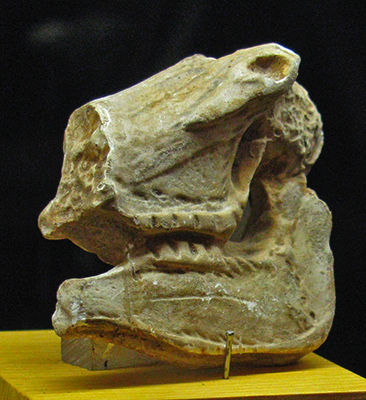
Sculpture of an animal head, possibly a horse, with the flesh removed. It would be very interesting to know what part horses played in this society, but it seems obvious they were at the least very important.
Photo: Don Hitchcock 2008
Source: Facsimile, display, Grotte du Mas d'Azil
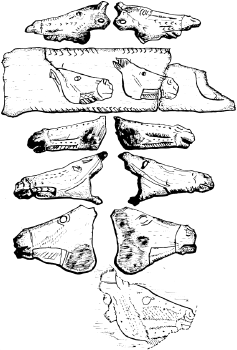
Le Mas d'Azil is famous for its horse heads. Some have what appear to be halters on them, indicative of domestication.
Note also the elongated horse heads, which have been carved from the hyoid bone of a horse, which places constraints on what shape the sculpture can take.
All these images come from Le Mas d'Azil except Lortet at the top and the 1975 discovery at Espalungue, Arudy at the bottom.
Photo: Hadingham (1979)

Contour découpé figurant une tête de cheval.
Horse heads, made from horse hyoid bones, which naturally form this shape, sometimes improved by careful shaping.
Photo: Don Hitchcock 2014
Source: Facsimile, Musée d'Archeologie Nationale et Domaine, St-Germain-en-Laye
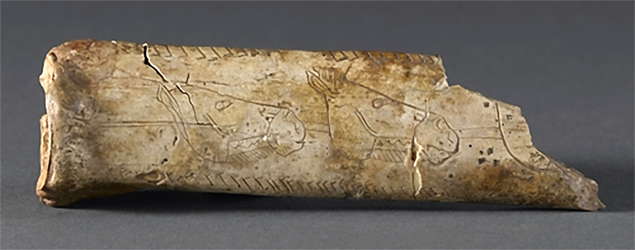
Engraved right metatarsal bone of reindeer depicting horse heads, from Le Mas d'Azil.
Middle/Upper Magdalenian, ca 15 000 - 11 000 years. Edouard Piette excavations, 1887-1894.
Photo and text adapted from: http://www.spectacles-selection.com/archives/expositions/fiche_expo_S/saint_germain_salle_piette/salle_piette_visuels.htm
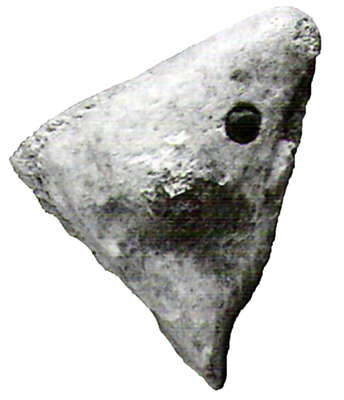
Sculpture in the round of a fish, Middle Magdalenian age, discovered by Péquart.
The carved fish head is a detached fragment of a more complete sculpture. The main interest of this small object is the presence of inlaid eyes. Two cupules hollowed at the site of the orbits are filled with a reddish substance, probably inserted in a malleable state, and described as a resin by the discoverer.
Inlaid eyes appear on many sculptures of Mas d'Azil, they are a singular feature, but we do find this practice on other sites sometimes.
Photo: http://www.arize.fr/Les-poissons.html
Text: Translated and adapted from http://www.arize.fr/Les-poissons.html
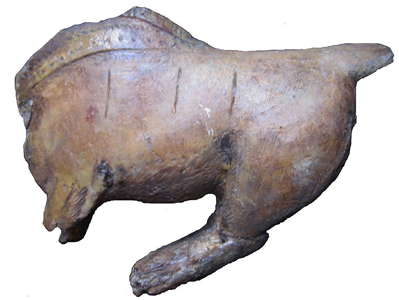
Bison sculpture from the Magdalenian discovered by Piette at Mas d'Azil.
The bison is carved from the palm of a reindeer antler whose thickness indicates that it was a male. An old fracture broke off the head, and breaks during excavation broke the legs, and the form suggests that the animal was connected to a long support, the stem of the reindeer antler forming the shank of either a propulseur or a bâton percé, a spear straightener, as on other objects from Mas d'Azil and elsewhere.
This very important sculpture shows the four legs, with an empty space under the belly of the bison. This feature is reminiscent of the famous series of 'Fawn and Birds' propulseurs or atlatls, also found at Mas d'Azil, and elsewhere.
The sculpture retains abundant traces of red ochre.
Photo: http://www.arize.fr/Sculptures-de-bisons.html
Text: Translated and adapted from http://www.arize.fr/Sculptures-de-bisons.html
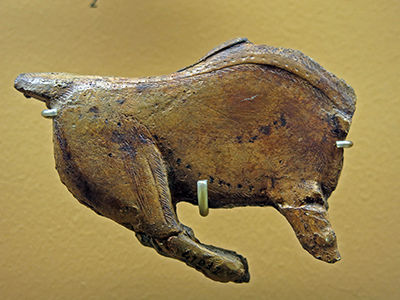
Bison sculptée en bois de renne.
Bison sculpted in reindeer antler.
This appears to be the obverse of the sculpture above.
Photo: Don Hitchcock 2014
Source: Facsimile, Musée d'Archeologie Nationale et Domaine, St-Germain-en-Laye
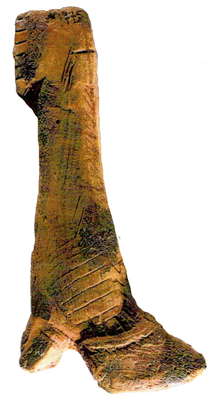
The leg of a bison, a sculpture from the middle Magdalenian, discovered by Péquart.
The cloven hoof and dew-claw are used to identify the leg as that of a bison, and there are several copies on the site.
On the left side, the beginning of a perforation indicates that the object should be seen as an unfinished pendant.
Photo: http://www.arize.fr/Sculptures-de-bisons.html
Text: Translated and adapted from http://www.arize.fr/Sculptures-de-bisons.html

Representation of two salmonids, a group which includes salmon and trout on a lissoir, or polisher, for stretching and preparing leather, a middle Magdalenian engraving discovered by Péquart.
Both ends of the piece are broken. On the preserved surfaces, two bodies of fish are shown in right profile, identifiable as salmonids by many details: the streamlined silhouette, the outer edge of the tail is straight, and by presence of a small adipose fin.
The adipose fin is a small fin, composed of fatty tissue, located between the dorsal (main fin on the fish's back) and caudal (tail) fins of some fish. Much like the appendix in humans, the purpose of the adipose fin is not clear.
However, the distinction cannot be made here between trout and salmon. The subjects fill the field that is available and each has been graphically developed, as if the artist wanted to clearly distinguish one from the other. Note the strongly incised lateral sensory line on the two fish.
Fish figures are slightly more common in moveable objects such as this than in parietal art, painted or engraved on walls.
Many cannot be identified to species, but most are salmonids, salmon and trout.
Photo: http://www.arize.fr/Les-poissons.html
Text: Translated and adapted from http://www.arize.fr/Les-poissons.html
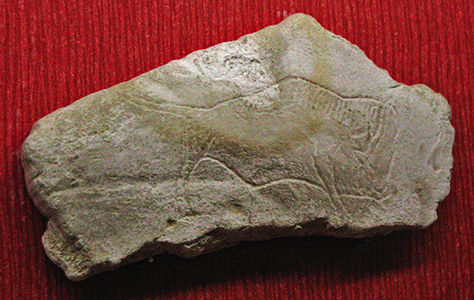
Pebble with an engraving of a bison.
Photo: Don Hitchcock 2008
Source: Facsimile, display, Grotte du Mas d'Azil
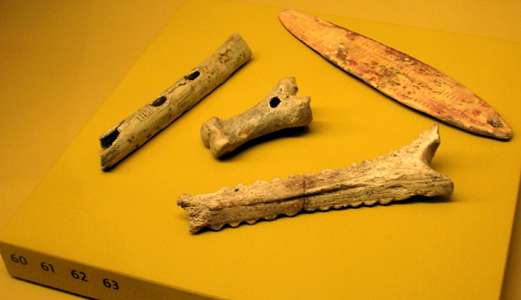
Music and dance are ephemeral art forms. However the existence of music
in the Palaeolithic is attested by the discovery of several
types of instruments: flutes, whistles, bull-roarers and scrapers.
Drums probably existed in the Paleolithic, but these instruments made of wood and skin are rarely if ever preserved. However, in some caves, calcite sheets or curtains showing traces of percussion testify to the rhythmical talents of prehistoric musicians.
60 (far left): Bone flute, facsimile, from Isturitz, Atlantic Pyrenees.
61 (centre): Whistle in bone, original, from Laugerie-Basse, Dordogne.
62 (top right): Bullroarer or rhombus or turndun, facsimile, in reindeer antler, Lalinde, Dordogne. Note the colour, originally from ochre, and the regular straight lines and rectangles decorating it.
63 (bottom right): Scraper, or scraped idiophone, original, from Mas d'Azil, Ariège. This one seems to have been made from a salvaged broken spear straightener.
Scraped idiophones (an idiophone is defined as a musical instrument from which the sound comes from the natural sonorous quality of the instrument itself, not from a stretched string or hide or enclosed column of air) are rasps or notched sticks over which another stick is scraped, resulting in a series of beats.
Photo: Kathy King 2010
Source: Image and translated and adapted text from the display at Musée d'archéologie nationale, Saint-Germain-en-Laye

Closeup of the idiophone from Mas d'Azil above.
Photo: Don Hitchcock 2015
Source: Original, Musée d'Archeologie Nationale et Domaine, St-Germain-en-Laye
Text: Rigaud (2001)
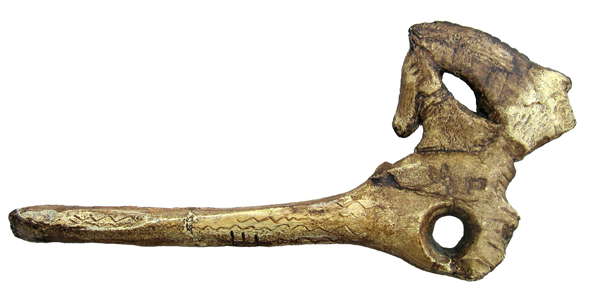
Spear straightener carved with a horse's head.
A representation of the head and neck of a horse and a single hoof.
This famous object, discovered near the propulseur 'the Fawn and the Birds', is carved from reindeer antler and fits the shape of the original material beautifully.
The head and neck of the horse follows the contours of the flat of the antler, and the shaft of the baton is carved into the shank of the antler.
The horse's withers are cracked and the antler surface has been weakened, and is partially delaminating. The hole in the object, obtained by gouging out from both sides, is perfectly regular.
On the far end of the piece, a double bevel has been cut. The two profiles of the horse are identical: a series of notches suggest the mane, eyes, ears and nostrils in bas relief, and there are three parallel incisions on the neck.
Under the head, the sculptor has created a partial hole, an artifice that gives great elegance to the curve of the neck, but the head of the animal is not entirely released from the rest of the piece, but is connected to it at the jowls.
To explain the presence of this 'tenon' or connecting material, there can be two possibilities:
1) The artist has left this connection so as not to completely detach the horse's head and avoid making the work fragile.
2) The sculpture is an unfinished work, as indicated by traces of cutting still visible on the jaw, in the right profile.
On the same profile, we see to the right of the hole just one leg of the horse indicated in bas relief and accompanied by six straight lines. The shank is decorated on both sides by wavy lines.
Photo: http://www.arize.fr/Protome-de-cheval.html
Text: Translated and adapted from http://www.arize.fr/Protome-de-cheval.html

This may be a spear thrower. It is decorated with three horse heads, one of which appears to be defleshed. This type of image, a defleshed horse head, occurs a number of times at Mas d'Azil, and may have had ritual significance.
Photo: http://anetcha-parisienne.blogspot.com.au/2012/09/en-passant-par-saint-germain-en-laye.html
Source: on display at Le Musée de Saint-Germain-en-Laye
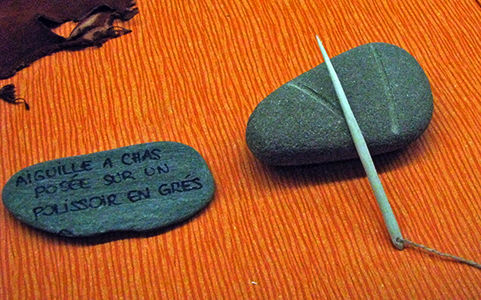
Bone sewing needle with a sandstone pebble used to shape it.
Photo: Don Hitchcock 2008
Source: Facsimile, display, Grotte du Mas d'Azil
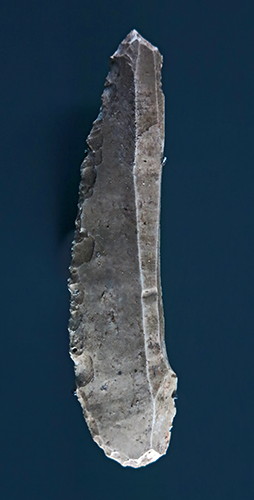
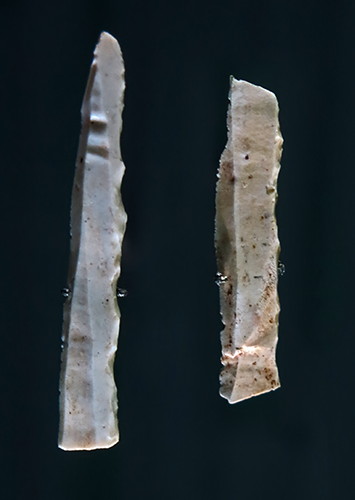
(left) Grattoir on a blade, with a great deal of retouch.
(right) Two small backed blades.
Grotte du Mas d'Azil.
Photo: Don Hitchcock 2015
Source: Original, Muséum de Toulouse, or Muséum d'Histoire Naturelle de la ville de Toulouse, MHNT
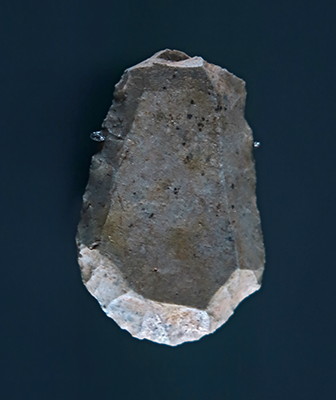

(left) Short grattoir.
(right) Combination grattoir and burin.
Grotte du Mas d'Azil.
Photo: Don Hitchcock 2015
Source: Original, Muséum de Toulouse, or Muséum d'Histoire Naturelle de la ville de Toulouse, MHNT
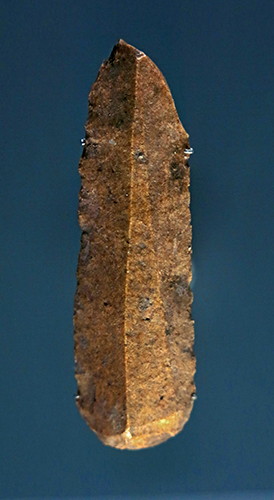
Combination grattoir and burin on a blade.
Grotte du Mas d'Azil.
Photo: Don Hitchcock 2015
Source: Original, Muséum de Toulouse, or Muséum d'Histoire Naturelle de la ville de Toulouse, MHNT


(left) 'Raw' blade, one which has not been retouched after striking it from the nucleus or core.
(right) Core or nucleus from which blades have been struck.
Grotte du Mas d'Azil.
Photo: Don Hitchcock 2015
Source: Original, Muséum de Toulouse, or Muséum d'Histoire Naturelle de la ville de Toulouse, MHNT
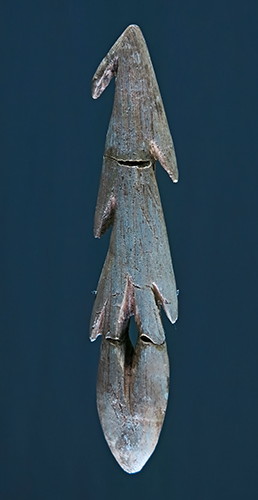
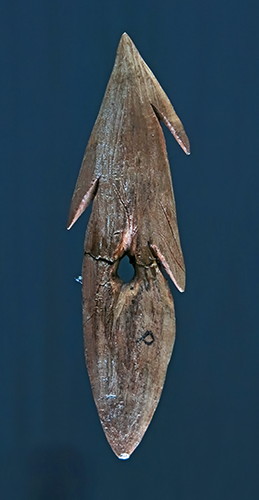
Harpoon heads.
Harpoons from Mas d'Azil and its culture are instantly recognisable, they are known as Azilian harpoons.
Grotte du Mas d'Azil.
Photo: Don Hitchcock 2015
Source: Original, Muséum de Toulouse, or Muséum d'Histoire Naturelle de la ville de Toulouse, MHNT
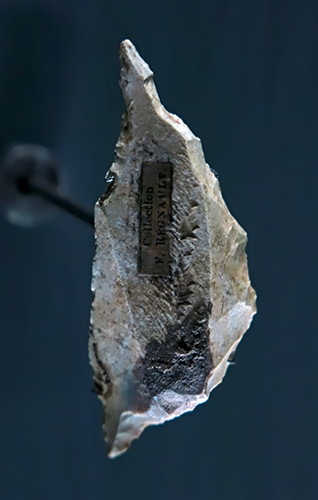
Perçoir or drill, double ended.
Grotte du Mas d'Azil.
Photo: Don Hitchcock 2015
Source: Original, Muséum de Toulouse, or Muséum d'Histoire Naturelle de la ville de Toulouse, MHNT
Azilian Points.
Grotte du Mas d'Azil.
Photo: Don Hitchcock 2015
Source: Original, Muséum de Toulouse, or Muséum d'Histoire Naturelle de la ville de Toulouse, MHNT
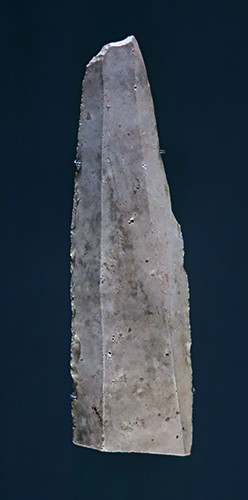
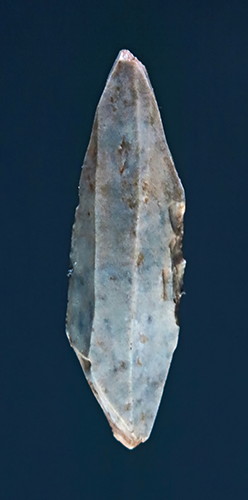
(left) Burin on a truncation.
(right) Double burin on a blade.
Grotte du Mas d'Azil.
Photo: Don Hitchcock 2015
Source: Original, Muséum de Toulouse, or Muséum d'Histoire Naturelle de la ville de Toulouse, MHNT
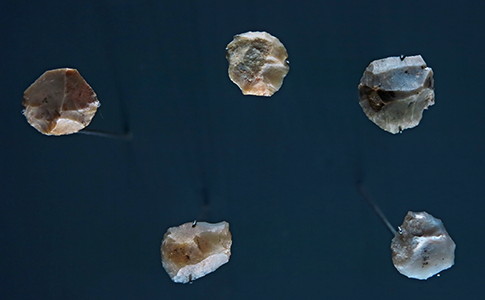
Unguiform (claw shaped) grattoirs.
Grotte du Mas d'Azil.
Photo: Don Hitchcock 2015
Source: Original, Muséum de Toulouse, or Muséum d'Histoire Naturelle de la ville de Toulouse, MHNT

Engraved horse shoulder blade discovered on the left bank of the Arize River at Mas d'Azil.
Photo: Delporte et al. (1976)

Multi perforated engraved disc from the Magdalenian discovered by Péquart.
This disc cut from an omoplate or shoulder blade, has sixteen holes evenly spaced around the circumference with an extra one in the centre.
On each side of the disc, an engraved line connects the perforations. The disc is decorated with two bands of engraved hatching along the diameter of both sides of the central hole. Six pairs of convergent dashes in a chevron shape are within the bands of hatching.
This type of geometric pattern associated with multiple perforations can be found on several other pieces of discs found at the site.
Photo: http://www.arize.fr/Rondelle-multi-perforee.html
Text: translated and adapted from http://www.arize.fr/Rondelle-multi-perforee.html
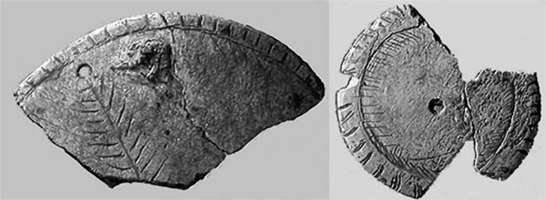
Engraved and perforated discs from Mas d'Azil.
(left) Disk with radiating barbed pattern.
(right) Disk with a central perforation, length 8cm.
Photo: Pleistocene Coalition News Vol 4, Issue 1, Jan-Feb 2012
Source: Saint-Germain en Laye Museum.
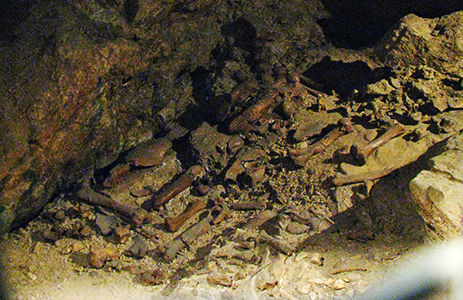
This was a poorly presented collection of bones found at le Mas d'Azil, including the distinctive shapes of mammoth teeth, in a badly lit alcove protected by steel mesh.
Photo: Don Hitchcock 2008
Source: Display, Grotte du Mas d'Azil

On the way up to a viewing platform.
Photo: Don Hitchcock 2008
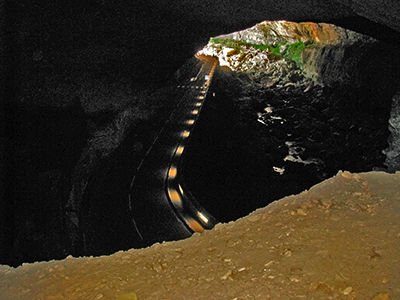
The viewing platform was high above the floor of the main cave and the southern entrance of the river and highway to the cave, with the pedestrian crossing to the display side cave entrance visible.
Photo: Don Hitchcock 2008
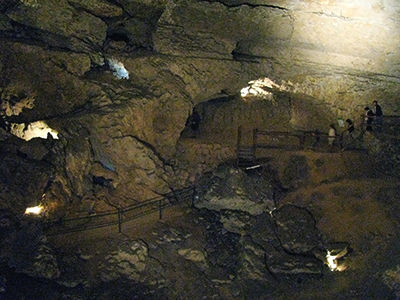
We returned the way we had come, to the side cave entrance, through the vast internal cavern.
Photo: Don Hitchcock 2008
Human figures, sculpted and engraved, found at Mas d'Azil.

Discovered by Édouard Piette, this little figurine was first described by him in 1888.
Piette (1888)
The figurine is 51 mm long, 17 mm wide and 13 mm thick, and has been sculpted in the root of a horse incisor. The shape was dictated to a large extent by the material used.
Photo: Duhard (1992)
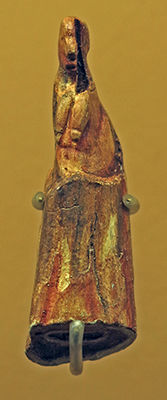
Another photo of the human figure above.
Photo: Don Hitchcock 2014
Source: Facsimile, Musée d'Archeologie Nationale et Domaine, St-Germain-en-Laye
Catalog: MAN47038
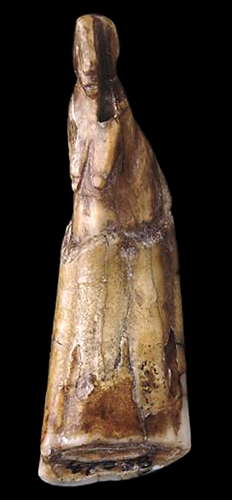
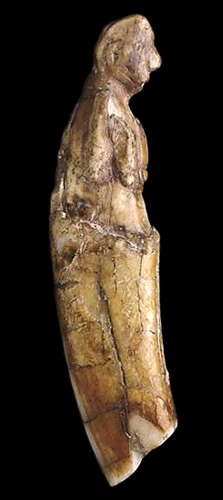
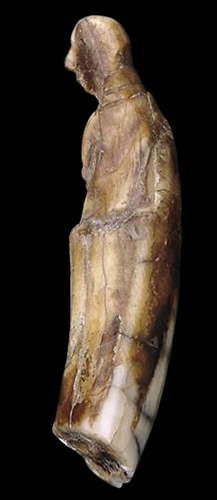
Another version of the Piette piece above, this view appears to be of the original.
Magdalenian, 16 000 - 15 000 BP
Photo: © RMN / Loïc Hamon
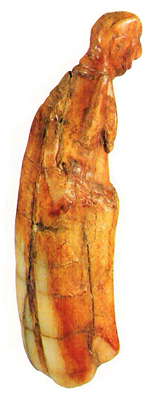
Yet another version of this important sculpture.
Sculpture of a female figure, from the middle Magdalenian, discovered by Piette.
This human bust, carved in the root of an incisor of a horse, shows a great mastery of sculptural technique. The nature, form and volume of material forced the sculptor to enclose the body within narrow limits.
The originality of this sculpture is reinforced by the representation of the breasts, elongated and pendant, but not bulky. This secondary sexual characteristic allows us to identify it as a woman.
Photo: http://www.arize.fr/La-Dame.html
Text: Translated and adapted from http://www.arize.fr/La-Dame.html
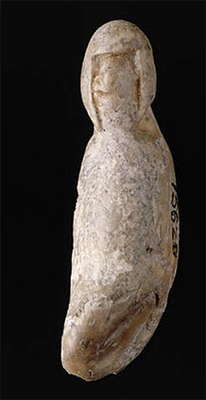
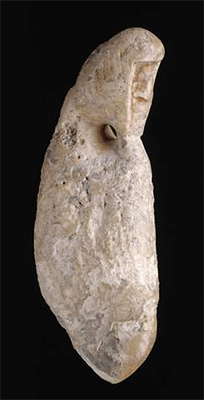
Note the similarity to the above of this piece from Bedeilhac.
Photo: picasaweb.google.com/byThemis/idolies
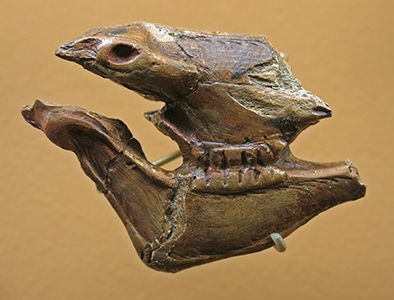
Tête de cheval décharnée sculptée en bois de renne.
Defleshed horse head sculpted in reindeer antler.
Photo: Don Hitchcock 2014
Source: Facsimile, Musée d'Archeologie Nationale et Domaine, St-Germain-en-Laye
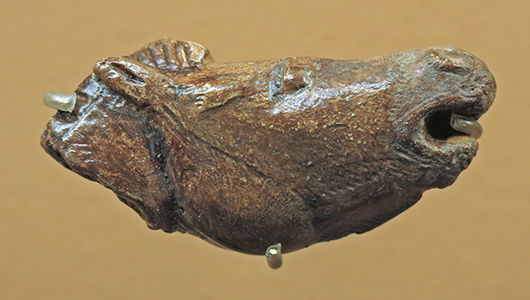
Tête de cheval hennisant sculptée en bois de renne.
Neighing horse head sculpted in reindeer antler.
Photo: Don Hitchcock 2014
Source: Facsimile, Musée d'Archeologie Nationale et Domaine, St-Germain-en-Laye

Bâton percé gravé figurant trois têtes de rennes.
Engraved spear straightener showing three reindeer heads.
(note that these appear to be swimming, as are many other depictions of reindeer. Swimming reindeer would have been much easier to hunt than those on land - Don )
Photo: Don Hitchcock 2014
Source: Facsimile, Musée d'Archeologie Nationale et Domaine, St-Germain-en-Laye
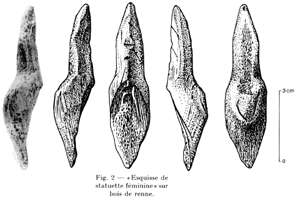
This female statuette, 72 mm x 17 mm carved from antler, reminds me strongly of the female/bird sculptures of Mezin.
It was first described by Chollot (1964)
Photo: Duhard (1992)

Man confronts a bear.
This is a stunning work. It consisted originally of a disk, with an engraving on each side.
Disk carved from a scapula (bovine?) Fragmented, 78 mm x 37 mm.
On one side of the disk, we have a human male with an erect penis confronting a bear, with a heavy stick over his shoulder, and on the other side, a man being struck down by a bear. He appears to be shown lying face down, and uniquely, there is no other palaeolithic representation of a man in such a position. If the disc is tipped upside down on this face, a horse may be seen.
It was first described in Piette (1902)
Photo: Duhard (1992)
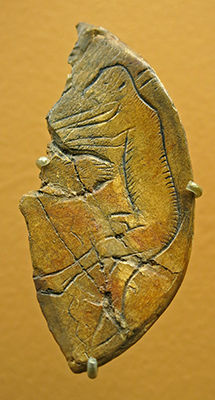
Rondelle découpée figurant un homme et une patte d'ours.
Disc showing a man and the paw of a bear.
Height 78 mm, width 37 mm.
Photo: Don Hitchcock 2014
Catalog: MAN48120
Source: Facsimile, Musée d'Archeologie Nationale et Domaine, St-Germain-en-Laye
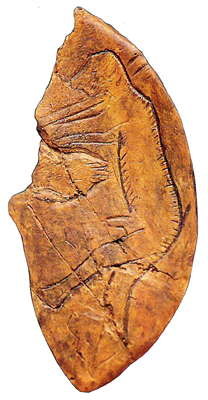
Another version of the man and bear.
Two representations of human figures, a horse, a bear and chevrons.
This exceptional piece is made of a scapula. This is the only representation of a composition combining the themes of bears and humans and a horse in a narrative sequence in the whole Palaeolithic corpus of art.
On the most famous face, the forelimb of the bear is directed toward the body of an upright man, looking to the left. Normally retracted, the bear's claws are out. The animal is on the offensive or defensive. The man is in a lively attitude. HIs left leg is lifted and his penis is erect, marking perhaps the effect of aggressive motivation, interpreted as a defensive reaction. HIs arms are stretched forward, and he carries on his right shoulder what appears to be a thick stick pointed at the animal. The theme of man being threatened by an animal is very rare throughout the Paleolithic iconographic furniture.
(cf the Lascaux bird man and disembowelled bison - Don )
On the reverse side, the scene seems to again be to the disadvantage of the human under threat by the same bear paw. The man was probably seen from the rear, and errors and omissions excepted, there is no other man seen from the rear in Paleolithic art.
If we tip the disc upside down on the reverse side, an engraving of the front of a horse, with a mane and high pronounced jaw appears.
Photo: http://www.arize.fr/Homme-au-bambou.html
Text: translated and adapted from http://www.arize.fr/Homme-au-bambou.html

Phallus from Mas d'Azil.
Phallus
Carved ivory
Cat 359
Origin : Mas-d’Azil cave, Ariège
Photo: © Loïc Hamon, Musée des Antiquités nationales, Saint-Germain-en-Laye.
Photo Source: http://www.culture.gouv.fr/culture/app/eng/96ce1735.htm
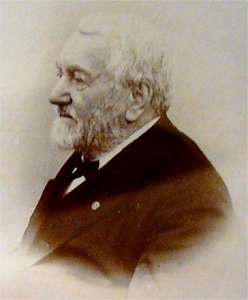
Portrait d'Édouard Piette ( 1827-1906)
Photo: Siren-Com
Tirage d'époque Archives du Musée d'archéologie nationale de Saint-Germain en Laye - France. (photographié en exposition)
Permission: Creative Commons Attribution Share Alike 3.0 Unported
Fauna of le Mas d'Azil
The excavations made at le Mas d'Azil in the Right Bank Gallery (of the Arize River) by Marthe and Saint-Just Péquart from 1937 to 1943 have delivered information on the material of the Magdalenian rich in portable art, in lithic and bone industries, and in animals. Although much information has been made available, the results for the fauna of the dig have not been published.
The results are given below. There were 2159 identified remains, mostly larger mammals and birds, which have been studied by Philippe Villette. Remains scattered and splintered by scavengers are rare.
| Species | Common Name | Number | MNI = Minimum Number of Individuals |
|---|---|---|---|
| Rangifer tarandus | Reindeer | 1268 | 92 |
| Cervus elaphus | Red Deer | 464 | 24 |
| Equus caballus | Horse | 174 | 12 |
| Bos primigenius | Aurochs | 17 | 7 |
| Bison priscus | Steppe Bison | 9 | 2 |
| Bos or Bison | Cattle or Bison | 150 | 15 |
| Capreolus capreolus | European Roe Deer or Chevreuil | 2 | 1 |
| Rupicapra rupicapra | Chamois | 13 | 3 |
| Capra ibex pyrenaïca | Spanish Ibex | 20 | 4 |
| Sus scrofa | Wild Boar | 2 | 1 |
| Canis lupus | Grey Wolf | 11 | 1 |
| Ursus spaeleus | Cave Bear | 4 | 1 |
| Crocuta spelaea | Cave Hyena | 4 | 2 |
| Vulpes vulpes | Red Fox | 20 | 5 |
| Oryctolagus cuniculus | European Rabbit | 1 | 1 |
References
- Alteirac A., Vialou D, 1984: Grotte du Mas d’Azil, in L’art des cavernes, Atlas des grottes ornées paléolithiques françaises, Imprimerie Nationale, Paris. p. 389-394.
- Bandi, H. , 1988: Mise bas et non défécation. Nouvelle interprétation de trois propulseurs magdaléniens sur des bases zoologiques, éthologiques et symboliques.Espacio, Tiempo y Forma, Série I, Prehistoria, t. I, 1988, pàgs. 133-147
- Cattelain, P. , 2005: Propulseurs magdaléniens: marqueurs culturels régionaux? In V. Dujardin (dir.), Industrie osseuse et parures du Solutréen au Magdalénien en Europe. Mémoire XXXIX de la Société préhistorique française : 301-317
- Chollot, M. , 1964: Musée des Antiquités nationales. Collection Piette. Art mobilier préhistorique, Paris, éd. des Musées Nationaux, 479 p.
- Delporte, H., Mons L., 1976: Omoplate décorée du Mas d’Azil, Antiquités Nationales, 7, pp 14-23.
- De Morgan, J. , 1924: Prehistoric Man (1924): A General Outline of Prehistory, Routledge, 2018 ISBN 1351347039, 9781351347037 Length 324 pages
- Duhard, J. , 1992: Les figurations humaines sculptées et gravées du Mas d'Azil (Ariège). Gallia préhistoire. Tome 34, 1992. pp. 289-301.
- Dupont, C., Marchand, G., 2014: Archéologie des chasseurs-cueilleurs maritimes de la fonction des habitats à l’organisation de l’espace littoral, Actes de la séance de la Société préhistorique française de Rennes, 10-11 avril 2014
- Guthrie, R.D., 2005: The nature of Paleolithic art Published by University of Chicago Press, 2005 ISBN 0226311260, 9780226311265 507 pages
- Hadingham, E. , 1979: Secrets of the Ice Age, Marboro Books
- Keith, A. , 1915: The Antiquity of man, Philadelphia: J.B. Lippincott company; London: Williams and Norgate
- Patou, M., 1984: La faune de la galerie Rive Droite du Mas d'Azil (Ariège) : données paléoclimatiques et paléthnographiques. Bulletin de la Société préhistorique française. 1984, tome 81, N. 10-12. Études et Travaux. pp. 311-319.
- Piette, E., 1888: Sur un buste de femme du Mas d'Azil, Matériaux pour l'histoire de l'homme, 3e série, 5, p. 378-379
- Piette, E., 1902: Gravure du Mas d'Azil et statuettes humaines de la période glyptique, Bulletin de la Societé d'Anthropologie de Paris, séance du 5 novembre.
- Plazy G., 2001: The History of Art in Pictures , MetroBooks
- Schiffer, M., 2001: Anthropological Perspectives on Technology, Amerind Foundation New World Studies Series, 2001
Back to Don's Maps
 Back to Archaeological Sites
Back to Archaeological Sites
